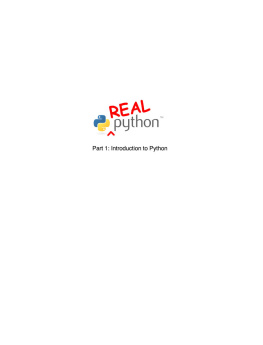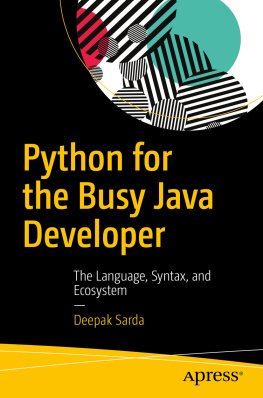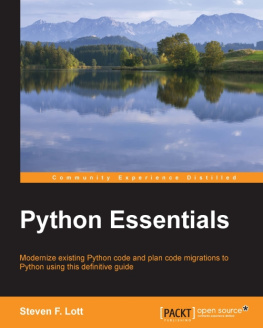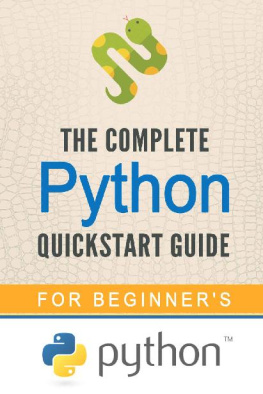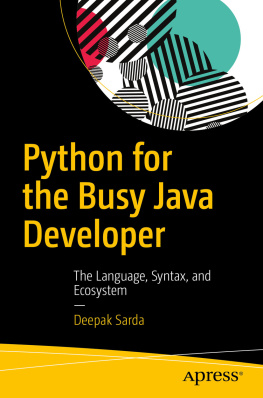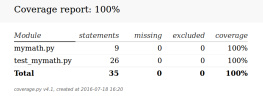NSA - comp3321 NSA Python Training Document
Here you can read online NSA - comp3321 NSA Python Training Document full text of the book (entire story) in english for free. Download pdf and epub, get meaning, cover and reviews about this ebook. genre: Computer. Description of the work, (preface) as well as reviews are available. Best literature library LitArk.com created for fans of good reading and offers a wide selection of genres:
Romance novel
Science fiction
Adventure
Detective
Science
History
Home and family
Prose
Art
Politics
Computer
Non-fiction
Religion
Business
Children
Humor
Choose a favorite category and find really read worthwhile books. Enjoy immersion in the world of imagination, feel the emotions of the characters or learn something new for yourself, make an fascinating discovery.
comp3321 NSA Python Training Document: summary, description and annotation
We offer to read an annotation, description, summary or preface (depends on what the author of the book "comp3321 NSA Python Training Document" wrote himself). If you haven't found the necessary information about the book — write in the comments, we will try to find it.
NSA: author's other books
Who wrote comp3321 NSA Python Training Document? Find out the surname, the name of the author of the book and a list of all author's works by series.
comp3321 NSA Python Training Document — read online for free the complete book (whole text) full work
Below is the text of the book, divided by pages. System saving the place of the last page read, allows you to conveniently read the book "comp3321 NSA Python Training Document" online for free, without having to search again every time where you left off. Put a bookmark, and you can go to the page where you finished reading at any time.
Font size:
Interval:
Bookmark:

The hidden page numbering which may be available to your ereader corresponds to the numbered pages in the print edition, but is not an exact match; page numbers will increment at the same rate as the corresponding print edition, but we may have started numbering before the print book's visible page numbers. The Internet Archive is working to improve the scanning process and resulting books, but in the meantime, we hope that this book will be useful to you. The Internet Archive was founded in 1996 to build an Internet library and to promote universal access to all knowledge. The Archive's purposes include offering permanent access for researchers, historians, scholars, people with disabilities, and the general public to historical collections that exist in digital format. The Internet Archive includes texts, audio, moving images, and software as well as archived web pages, and provides specialized services for information access for the blind and other persons with disabilities. Created with abbyy2epub (v.1.7.6) (U)
Recommendations (b) (3)-P.L. 86-36
During the first week, the ten lessons are covered with morning and afternoon lectures. During the second week, up to ten modules are covered in a similar manner, as needed or requested by the students in the class. (If the class needs are not known, take a vote). During the first few days of class, students should choose a project to work on. On the last day, students should report back on their progress and, if possible, demonstrate their work. (U) The two week block is not the only way of teaching the course. (U) The two week block is not the only way of teaching the course.
The material could be presented at a more leisurely pace, for instance during a weekly brown bag lunch that continues for several months. Alternatively, if students are already prepared (or willing to do some of the initial lessons in a self-study manner), a great deal can be accomplished in a two or three day workshop. For instance, if all students already have a basic knowledge of Python, they might well start with the lessons on tooling and writing modules and packages, then move on to cover various modules of interest. Approved for Release by NSA on 12-02-2019, FOIA Case # 108165
This session can either be a terminal session or a Jupyter notebook. The important detail is that in most cases the commands should not be pre-populated; e.g. you should not just execute cells from an existing Jupyter notebook. The materials are present to help you prepare, and as a reference for the students as they work on exercises; they are not an acceptable substitute for the shared experience of teaching and learning. You will make unexpected mistakes as you write code live in front of the class. Don't worry, relax, and let the students help you~it will help them learn the principles and figure out how to solve their own problems.
This is not a substitute for proper preparation; too many mistakes and fumbles will cause your students to lose interest in the course and trust in you.
If you want to make changes for your own purposes, feel free to clone that repository or fork any of these notebooks on the Juptyer Gallery. Please submit a change request on the Gallery if you'd like to make a one-off contribution, including new or improved exercises, additions to lessons or modules, or entirely new lessons or modules. If you would like to be a collaborator on all of the COMP 3321 notebooks, contact the COMP3321 GlobalMe group and ask to be added.
Clearly explain the task, showing where in the room the instructor will begin and how big a step is. (U) Take suggestions from students about what instructions they will want to use. Write each instruction on the board. Be clear that everything written on the paper must come from syntax on the board. No other syntax allowed. (U) Make sure the instructor and students agree about precisely what each instruction means.
As the instructor, be certain the list on the board is enough for you to solve the problem. Give hints until its complete. (U) Let the students come up with the syntax. But here are some syntax examples they may come up with. step(n) takes in an integer and causes instructor to take n steps. tum(d) - takes in a number in degrees and caused instructor to turn clockwise that many degrees.
Students may abuse this and put in numbers that lead to dizzyness, e.g. tum(1440) obstacle -- returns boolean indicating rather an obstacle is directly in front of instructor. Variations for checking to the left or right may be desirable as well. if < > then < > else < > first blank takes boolean (make sure boolean functions exist!). Second blanks take instructions. (U) Each team produces a piece of paper with computer instructions for the human compiler to get out of the room. (U) Each team produces a piece of paper with computer instructions for the human compiler to get out of the room.
Only allowable syntax is what is written on the board. Should take no more than 15 minutes. (U) Phase III -- demonstrations (U) One at a time, the instructor takes a team's solution and follows the instructions, literally and fairly. Does the instructor get out of the room?
Next pageFont size:
Interval:
Bookmark:
Similar books «comp3321 NSA Python Training Document»
Look at similar books to comp3321 NSA Python Training Document. We have selected literature similar in name and meaning in the hope of providing readers with more options to find new, interesting, not yet read works.
Discussion, reviews of the book comp3321 NSA Python Training Document and just readers' own opinions. Leave your comments, write what you think about the work, its meaning or the main characters. Specify what exactly you liked and what you didn't like, and why you think so.


